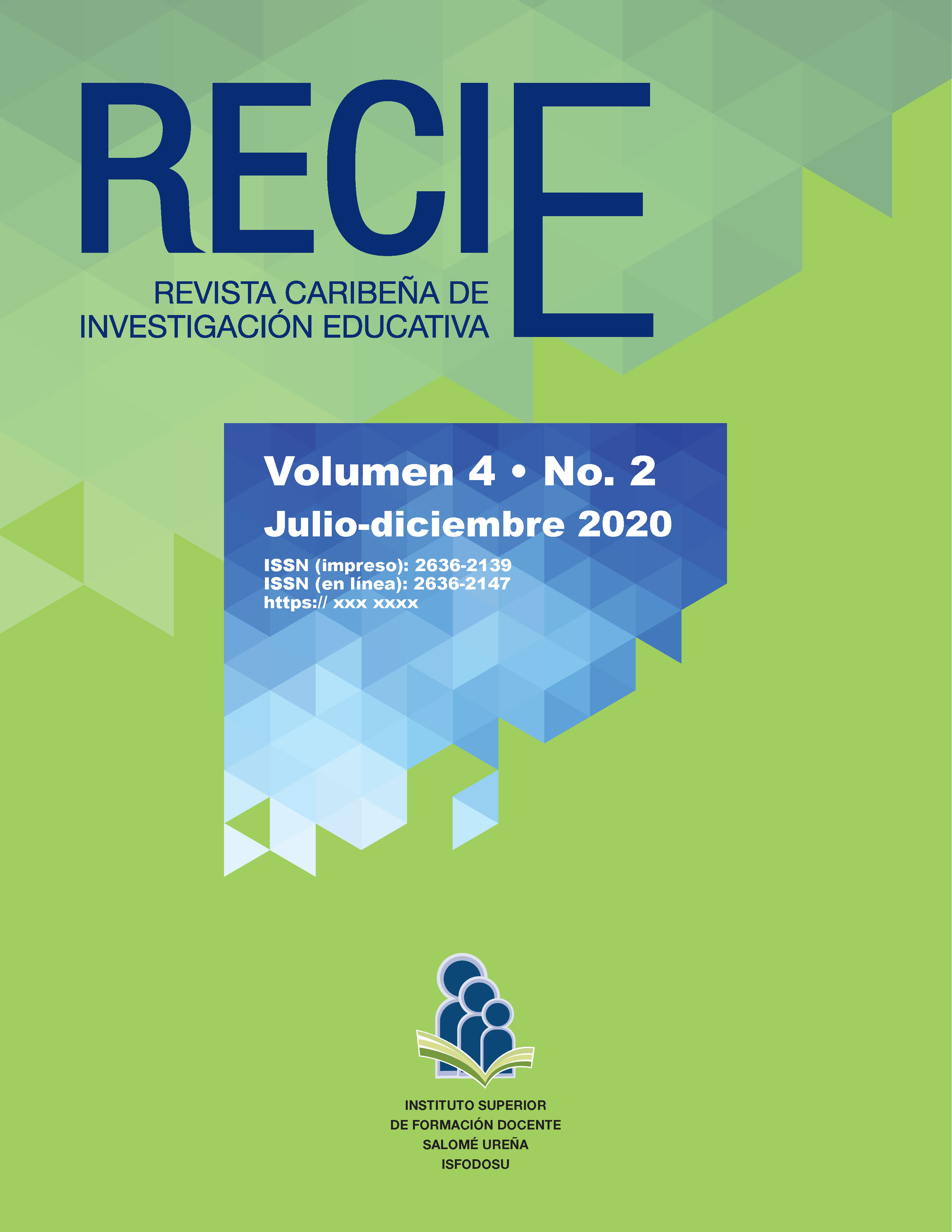Effects of a Literacy Intervention on Reading Skills of Primary School Students: Project USAID Read
Authors
Laura Virginia Sánchez-Vincitore
Universidad Iberoamericana (UNIBE)
[email protected] https://orcid.org/0000-0002-6343-1217Aída Mencía-Ripley
Universidad Iberoamericana (UNIBE)
[email protected] https://orcid.org/0000-0001-7510-4072Carlos B Ruiz-Matuk
Universidad Iberoamericana (UNIBE)
[email protected] https://orcid.org/0000-0003-2681-4953Detalles
Published
Abstract
Project USAID Read is a reading and writing intervention in public schools in the Dominican Republic, in response to its low levels of reading comprehension. To determine the effectiveness of project USAID Read through two cross-sectional studies (at the beginning of the project and in the middle). An experimental study was carried out with randomization of groups (experimental vs. control) and an estimate of the counterfactual based on the baseline evaluation. Second grade students (N = 2,399) participated in the baseline study, and fourth grade students (N = 2,359) participated in the midline study. They were tested on reading comprehension and its precursor skills (oral comprehension, phonological awareness, letter knowledge, words per minute, pseudowords per minute and fluency), and general cognitive abilities (working memory for words and pseudowords). There were no differences between the groups at baseline. In the midline study, the experimental group obtained better scores than the control group in oral comprehension, phonological awareness, letter knowledge, words and pseudowords per minute and working memory for pseudowords. There were no differences between the groups in fluency or reading comprehension. We concluded that the intervention was effective but had not yet reached the threshold necessary for its effects to be reflected beyond the reading comprehension precursor skills. The results are interpreted under the theory of reading automaticity and the need for greater independent reading practice while students learn to read.
Keywords
How to Cite
Downloads
Metrics
References
Abadzi, H. (2012). Developing cross-language metrics for reading fluency measurement: Some issues and opportunities. GPE Working Paper Series on Learning No. 6.
Castles, A., Rastle, K., & Nation, K. (2018). Ending the reading wars: Reading acquisition from novice to expert. Psychological Science in the Public Interes, 19(1), 551. https://doi.org/10.1177/1529100618772271
Cohen, J. (1998). Statistical power analysis for the behavioral sciences (Second). Hillsdale, NJ, England: Lawrence Erlbaum Associates, Inc, Hillsdale, NJ.
Dehaene, S. (2015). Aprender a leer: De las ciencias cognitivas al aula. Buenos Aires: Siglo Veintiuno Editores.
Ehri, L. C. (1987). Learning to read and spell words. Journal of Literacy Research, 19(1), 531. https://doi.org/10.1080/10862968709547585
Ehri, L. C. (2005a). Development of sight word reading: Phases and findings. En M. J. Snowling & C. Hulme (Eds.), The science of reading: A handbook (pp. 135-145). Oxford: Blackwell Publishing.
Ehri, L. C. (2005b). Learning to read words: Theory, findings, and issues, Scientific Studies of Reading, 9(2), 167-188. https://doi.org/10.1207/s1532799xssr0902_4
Ferreiro, E., & Teberosky, A. (1979). Los sistemas de escritura en el desarrollo del niño. México: Siglo XXI Editores.
Frith, U. (1985). Beneath the surface of developmental dyslexia. Surface Dyslexia. https://doi.org/10.1016/j.jconhyd.2010.08.009
Gertler, P. J., Martínez, S., Premand, P., Rawlings, L. B., & Vermeersch, C. M. (2011). La evaluación de impacto en la práctica. The World Bank.
Ganimian, A.J., & Murnane, R.J. (2016). Improving education in developing countries: Lessons from rigorous impact evaluations. Review of Educational Research, 86 (3), 719-755.
Graham, J., & Kelly, S. (2018). How effective are early grade reading interventions? (Policy Research Working Paper No. 8292). https://bit.ly/2I3PjsD
Hoover, W. A., & Gough, P. B. (1990). The simple view theory of reading. Reading and Writing: An Interdisciplinary Journal, (2), 127-160.
Joyce, B. R., & Showers, B. (2002). Student Achievement Through Staff Development. Alexandria, VA.
Kirby, J. R., & Savage, R. S. (2008). Can the simple view deal with the complexities of reading? Literacy, 42(2), 75-82. https://doi.org/10.1111/j.1741-4369.2008.00487.x
Kraft, M. A. (2018). Interpreting effect sizes of education interventions. Brown University Working Paper.
LaBerge, D., & Samuels, S. J. (1974). Toward a theory of automatic information processing in reading. Cognitive Psychology, 6(2), 293-323. https://doi.org/10.1016/0010-0285(74)90015-2
Martínez, L., Herrera, C., Valle, J., & Vásquez, M. (2011). Memoria de trabajo fonológica en preescolares con trastorno específico del lenguaje expresivo. Psykhe, 12(2).
Mencía-Ripley, A., Sánchez-Vincitore, L. V., Garrido, L. E., & Aguasvivas-Manzano, J. A. (2016). Baseline report of USAID-Leer. Santo Domingo.
MINERD (2014). Diseño curricular: Nivel primario.
MINERD (2018a). Resultados de la evaluación diagnóstica nacional de sexto grado de primaria. Informe nacional. Santo Domingo.
MINERD (2018b). Resultados de la evaluación diagnóstica nacional de tercer grado de primaria: Informe nacional. Santo Domingo.
OECD. (2019). Programme for international student assessment (PISA): Results from PISA 2018. https://www.oecd.org/pisa/publications/PISA2018_CN_DOM.pdf
Powell, D. R., & Diamond, K. E. (2013). Implementation fidelity of a coaching-based professional development program for improving Head Start teachers’ literacy and language instruction. Journal of Early Intervention, 35(2), 102-128. https://doi.org/10.1177/1053815113516678
Pressley, M. (2002). Balanced literacy instruction. Focus on Exceptional Children, 34(5), 114.
Samuels, S. J. (2004). Toward a theory of automatic information processing in reading, revisited. En R. B. Ruddell & N. J. Unrau (Eds.), Theoretical models and processes of reading (pp. 1127-1148). Newark, DE: International Reading Association.
Sánchez-Vincitore, L. V. (2018). Creación de una colección de libros decodificables para la práctica lectora inicial en el idioma español. Ciencia y Educación, 2, 6372.
Sánchez-Vincitore, L. V. (2019). Proyecto USAIDLeer: Lecciones aprendidas para la toma de decisiones de políticas educativas. En XV Congreso Latinoamericano para el Desarrollo de la Lectura y Escritura (CONLES). https://doi.org/10.22235/cp.v3i2.147
Stone, R., De Hoop, T., Coombes, A., & Nakamura, P. (2019). What works to improve early grade literacy in Latin America and the Caribbean? A systematic review and meta-analysis. Campbell Systematic Reviews, 16(1), e1067. https://doi.org/10.1002/cl2.1067
UNESCO. (2008). Primer reporte de los resultados del Segundo Estudio Regional Comparativo y Explicativo. Santiago.
UNESCO. (2015). Tercer estudio regional comparativo y explicativo: Informe de resultados. Santiago. http://unesdoc.unesco.org/images/0024/002435/243532S.pdf
UNESCO. (2017). Accountability in education: Meeting our commitments. Paris. https://doi.org/10.1017/CBO9781107415324.004
USAID. (2011). Opportunity through learning: USAID education strategy. Washington, D.C.
Walker, B. J. (2012). Diagnostic teaching of reading: Techniques for instruction and assessment (7th ed.). Boston, MA: Pearson Education, Inc.
Wood, C., Goodnight, C., Bethune, K., Preston, A., & Cleaver, S. (2016). Role of professional development and multi-level coaching in promoting evidence-based practice in education. Learning Disabilities - A Contemporary Journal, 14(2), 159-170.
